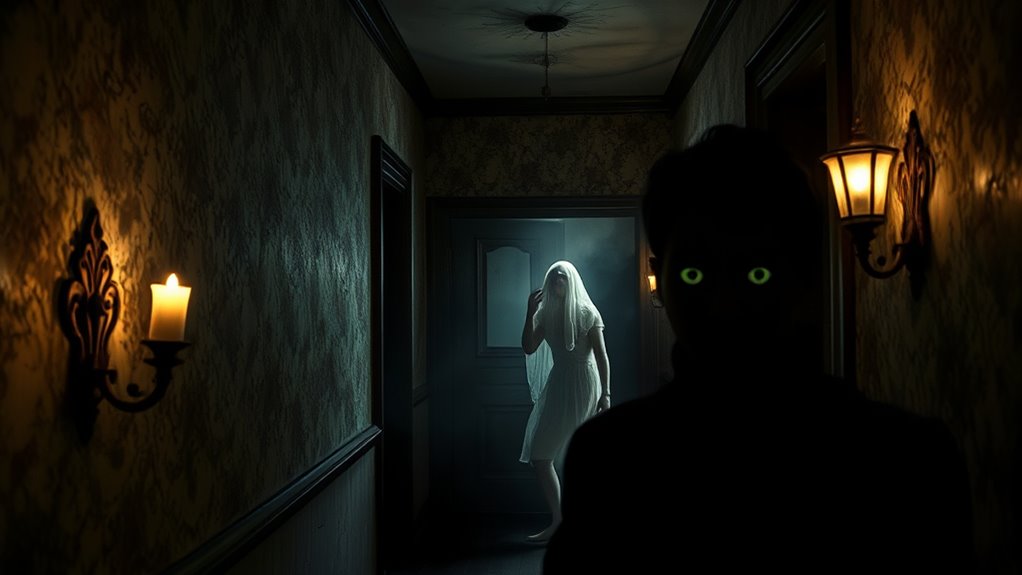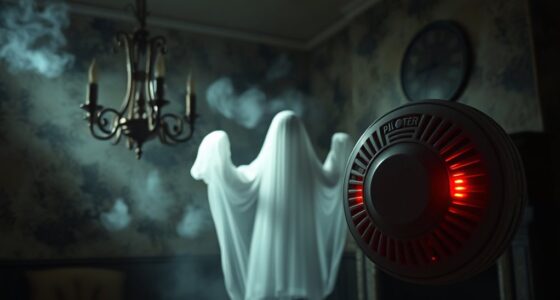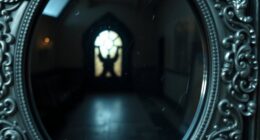When you enter a haunted location, your brain is primed to notice paranormal sights, sounds, and sensations because of the environment’s reputation and your beliefs. Expectations heighten your sensitivity, making normal noises or drafts seem supernatural. Environmental cues and suggestibility amplify these perceptions, creating vivid illusions of hauntings. Your mind fills in gaps, influenced by biases and stories, making experiences seem more real than they are. Exploring further reveals how your mind shapes what you perceive in these eerie spaces.
Key Takeaways
- Expectations heighten suggestibility, causing individuals to interpret ambiguous stimuli as paranormal.
- Psychological biases like confirmation bias focus attention on evidence supporting haunted beliefs.
- Sensory perception filters normal environmental cues, leading to false alarms such as creaks or drafts.
- Suggestion amplifies awareness of subtle cues, making minimal stimuli seem like supernatural encounters.
- Understanding these psychological and environmental factors helps differentiate real phenomena from perception-based illusions.

Many haunted locations seem to come alive with eerie phenomena because our minds are more suggestible in such settings. When you walk into a place with a reputation for ghosts or paranormal activity, your brain is primed to notice strange sights, sounds, and sensations. This heightened expectation influences how you interpret your sensory perception, often turning ordinary occurrences into extraordinary experiences. Your psychological biases, shaped by stories, legends, and prior beliefs, play a significant role in what you perceive and how you interpret it. If you believe a location is haunted, you’re more likely to notice unexplained noises or shadows and attribute them to supernatural causes.
Your sensory perception is not a flawless window to reality but a filter heavily influenced by your expectations. When you’re in a spooky environment, your mind expects to see or hear something unusual, which can lead to false alarms. For example, creaking floorboards may be interpreted as footsteps, or a draft might be mistaken for a cold breeze carrying a ghostly presence. This is where psychological biases come into play. Confirmation bias, for instance, makes you focus on evidence that supports your belief in hauntings while ignoring conflicting information. If you hear a strange noise, you’re more likely to interpret it as a paranormal event if you already believe the place is haunted.
The power of suggestion further amplifies these effects. If a guide or a sign hints at supernatural activity, you become more receptive to subtle cues. This heightened suggestibility means your mind fills in gaps, creating a vivid experience from minimal stimuli. Your expectation acts like a lens, sharpening some perceptions while blurring others, leading you to see or hear things that aren’t truly there. This phenomenon isn’t just psychological; it’s rooted in how your brain processes sensory information under influence. Additionally, research on vetted safety products shows how environmental factors can be controlled to reduce false perceptions, illustrating that many experiences attributed to hauntings could be mitigated by understanding sensory influences.
In haunted locations, your psychological biases and the way your sensory perception operates combine to craft compelling, often frightening experiences. You’re not just an innocent observer; your beliefs and expectations actively shape what you perceive. Recognizing this can help you understand that many ghostly encounters are less about spirits and more about the mind’s fascinating ability to interpret ambiguous stimuli based on context, prior knowledge, and suggestion. So, the next time you find yourself in a haunted place, remember that your brain’s biases and perception are powerful tools—sometimes tricking you into believing in things that aren’t really there.
Frequently Asked Questions
Can Expectation Effects Vary Across Different Cultures?
Yes, expectation effects can vary across cultures because cultural beliefs shape perception biases. If your culture views haunted locations as real or spiritually significant, you’re more likely to experience heightened expectations and perceive strange phenomena. Conversely, in cultures with skeptical views, you’re less prone to such effects. Your cultural background influences how your mind interprets ambiguous stimuli, ultimately affecting your haunted location experiences.
Are There Specific Environmental Factors That Enhance Expectation Effects?
Yes, certain environmental factors can enhance expectation effects. Psychological priming plays a role; if you’re told a place is haunted, your mind becomes more receptive to perceived paranormal activity. Ambient stimuli like dim lighting, eerie sounds, or cold drafts heighten your sensitivity, making you more likely to interpret ordinary sensations as supernatural. These factors work together to amplify your expectations, increasing the likelihood of experiencing belief-influenced phenomena in haunted locations.
How Do Expectation Effects Influence Memory Recall in Haunted Settings?
Expectation effects can substantially influence your memory recall in haunted settings, acting like a placebo influence that shapes what you remember. When you anticipate paranormal activity, your brain may interpret ambiguous stimuli as evidence of ghosts, reinforced by sensory adaptation to the environment. This means your memories become biased, making you more likely to recall spooky encounters, even if they didn’t happen, driven by your expectations rather than actual events.
Can Expectation Effects Be Intentionally Manipulated for Entertainment or Research?
Yes, you can intentionally manipulate expectation effects for entertainment or research, like a puppeteer pulling strings. By applying suggestion techniques and harnessing placebo influence, you can shape how people perceive haunted locations. This method guides their expectations, making them more prone to experiencing eerie phenomena. Carefully crafted suggestions can amplify the spooky atmosphere, demonstrating how powerful the mind can be in creating ghostly encounters, whether for fun or scientific exploration.
What Neurological Processes Are Involved in Expectation-Induced Experiences?
When you experience expectation-induced effects, neural activation in your brain’s sensory processing areas increases, amplifying certain sensations or perceptions. Your brain interprets these heightened signals based on prior beliefs, leading you to perceive ghosts or eerie phenomena even when there’s no actual threat. This process involves complex neural pathways that link expectation, attention, and sensory input, shaping how you interpret ambiguous stimuli during haunted locations.
Conclusion
As you step into a haunted location, your mind becomes a flickering lantern in the darkness, casting shadows of expectation that dance and shift. The creak of a floorboard or whisper of the wind transforms into ghostly whispers, fueled by your beliefs and fears. Remember, it’s your mind’s vivid imagination playing tricks, turning an ordinary space into a haunting scene. Embrace the mystery, knowing that sometimes, the most mesmerizing spirits are born from your very own expectations.









